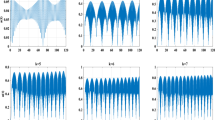Summary
Many solid-state lasers show features which have not been predicted by the prevalent laser theories. The laser action in a ruby crystal usually produces a spotty pattern on the end faces, and the output exhibits relaxation oscillations in a random manner. These properties are closely connected with one another through the filamentary nature of the laser action. The theory for a Fabry-Perot interferometer with rectangular mirrors and a large Fresnel number is outlined. It is demonstrated that the observable single mode patterns are in the form of parabolic cylinder functions (Gaussian distribution of intensity for lowest-order eigenmode) and not of cosine and sine functions as is widely believed. This theoretical result predicts the filamentary nature of the laser action between plane parallel end faces and suggests that the irregular spiking behavior of a solid-state laser may be considered a superposition of outputs from several filaments. If the laser is operated only slightly above threshold the relaxation oscillations die away faster than predicted by the linearized Statz and deMars equations.
Similar content being viewed by others
References
Schawlow, A. L. and C. H. Townes, Phys. Rev.112 (1958) 1940.
Collins, R. J., D. F. Nelson, A. L. Schawlow, W. Bond, C. G. B. Garrett and W. Kaiser, Phys. Rev. Letters5 (1960) 303.
Nelson, D. F. and R. J. Collins, J. Appl. Phys.4 (1961) 739.
Nelson, D. F. and R. J. Collins, “The Polarization of the Output from a Ruby Optical Maser”; Advances in Quantum Electronics, pp. 79–82, Columbia University Press, New York and London, 1961.
Hercher, M., Appl. Optics1 (1962) 665.
Tonks, L., J. Appl. Phys.33 (1962) 1980.
Evtuhov, V. and J. K. Neeland, Appl. Optics1 (1962) 517.
Evtuhov, V. and J. K. Neeland, “Characteristics of Ruby Laser Modes in a Nominally Plane Parallel Resonator”; Quantum Electronics, Paris 1963 Conference, Vol. 2, pp. 1405–1414, Columbia University Press, New York 1964.
Leontovich, A. M. and A. P. Veduta, Sov. Phys. JETP,19 (1964), 51.
Stickley, C. M., Appl. Optics3 (1964) 967; also Physical Sciences Research Papers, No. 19, AFCRL-64-434, May 1964 (Air Force Cambridge Research Laboratories, L. G. Hanscom Field, Mass.).
Statz, H. and G. deMars, “Transients and Oscillation Pulses in Masers”; Quantum Electronics, ed. by C. H. Townes, pp. 530–537, Columbia University Press, New York, 1960.
Sorokin, P. P. and M. J. Stevenson, “Stimulated Emission from CaF2: U+3 and CaF2 : Sm+2”; Advances in Quantum Electronics, ed. by J. R. Singer, pp. 65–76, Columbia University Press, New York and London, 1961.
Lotsch, H., Phys. Letters12 (1964) 99; also Phys. Letters16 (1965) 45.
Lotsch, H., Bull. Amer. Phys. Soc. Series II9 (1964) 729.
Lotsch, H., Phys. Letters11 (1964) 221.
Lotsch, H., Z. Naturforschung20a (1965) 38.
Meixner, J. and F. W. Schaefke, Mathieusche Funktionen und Sphaeroidfunktionen, Springer-Verlag, Berlin, Goettingen, Heidelberg, 1954.
Lotsch, H., Z. angew. Phys.19 (1965) 162.
Hughes, T. P. and K. M. Young, Nature196 (1962) 332.
Kisliuk, P. and D. J. Walsh, Appl. Optics1 (1962) 45; see also Weisman, D., Appl. Optics1 (1962) 672.
Dayhoff, E. S., Proc. IRE50 (1962) 1684.
Tang, C. L., H. Statz and G. deMars, Appl. Phys. Letters2 (1963) 222.
Crowe, J. W., Paper WB 13, Spring Mtg. Optical Society of America, Jacksonville, Florida, March 1963; see J. Opt. Soc. of America53 (1963) 522.
Dayhoff, E. S., “The Emission Mode Patterns of Ruby Lasers”; Proceedings of the X-th Colloquium Spectroscopicum Internationale, pp. 421–436.
Dayhoff, E. S., “Transverse Mode Patterns in Neodymium Glass and Ruby”; Quantum Electronics, Paris 1963 Conference, Vol. 2, pp. 1445–1451, Columbia University Press, New York, 1964.
Stitch, M. L., E. J. Woodbury and J. H. Morse, “Stimulation versus Emission in Ruby Optical Masers”; Advances in Quantum Electronics, pp. 83–84, Columbia University Press, New York and London, 1961.
Stickley, C. M., Appl. Optics2 (1963) 855.
Bortfeld, D. P., R. S. Congleton, M. Geller, R. S. McComas, L. D. Riley, W. R. Sooy and M. L. Stitch, J. Appl. Phys.35 (1964) 2267.
Li, T. and S. D. Sims, Proc. IRE50 (1962) 464.
Devlin, G. E., J. McKenna, A. D. May and A. L. Schawlow, Appl. Optics1 (1962) 11.
McKenna, J., Appl. Optics2 (1963) 303.
Svelto, O. and M. DiDomenico, Appl. Optics2 (1963) 431.
Sooy, W. R. and M. L. Stitch, J. Appl. Phys.34 (1963) 1719.
Dunsmuir, R., J. Electr. Control10 (1961) 453.
Birnbaum, M., T. Stocker and S. J. Welles, Proc. IEEE51 (1963) 854.
Roess, D., Z. Naturforschung19a (1964) 1169.
Shimoda, K., “Amplitude and Frequency Variations in Ruby Optical Masers”;Optical Masers, MRI Symposia Series, Vol. XIII, ed. J. Fox, pp. 95–108, Wiley-Interscience, New York, 1963.
Korpel, A. and J. Free, Proc. IEEE52 (1964) 619.
Roess, D., Frequenz17 (1963) 61.
Roess, D., Proc. IEEE52 (1964) 196.
Lotsch, H., “A Modified Fabry-Perot Interferometer as a Discrimination Filter and a Modulator for Longitudinal Modes”; Scientific Report No. 2, AFCRL-62-748, Quantum Electronics Laboratory, California Institute of Technology, Pasadena, California, September 1, 1962.
Lotsch, H., Jap. J. Appl. Phys.4 (1965) 435.
Siegman, A. E., “Small Mirror Transverse-Mode Control and Near-Field Rings in Ruby-Laser Rod”; Paper TB 14, Spring Meeting, Optical Society of America, Washington, D.C., April 1964; see J. Opt. Soc. America54 (1964) 567.
Lotsch, H., Proc. IEEE53 (1965) 398.
Lotsch, H., Physica31 (1965) 1796.
Siegman, A. E., Stanford University, Stanford, California (private communication).
Welling, H., C. J. Bickart and H. G. Andresen, IEEE Journal of Quantum Electronics1 (1965) 223.
Lotsch, H., Ann. der Physik (7)16 (1965) 7.
Roess, D., ‘Optical Pumping Systems and CW Ruby Lasers’ WINCON '66, Los Angeles, California, February 2–4, 1966, Conference Record, pp. IIIB-6 to IIIB-11
Roess, D., Z. Naturforschung20a (1965) 1348.
Author information
Authors and Affiliations
Rights and permissions
About this article
Cite this article
Lotsch, H.K.V. On the filamentary nature of laser action. Appl. Sci. Res. 12, 451–469 (1965). https://doi.org/10.1007/BF00382138
Issue Date:
DOI: https://doi.org/10.1007/BF00382138




